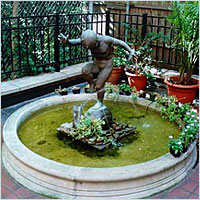 The brownstone in which Casa Italiana is located was built between 1851-1852 by Charles Partridge. The style is Anglo-Italianate, as is revealed by the large paneled cornice and the decorations on the doors and windows.
The brownstone in which Casa Italiana is located was built between 1851-1852 by Charles Partridge. The style is Anglo-Italianate, as is revealed by the large paneled cornice and the decorations on the doors and windows.
Today the Casa hosts classrooms for seminars and conferences, offices for professors and administrative personnel, a library (in what was General Scott's parlor), and, in the basement, an auditorium. The elegant marble atrium, constructed around two original columns (two others were added later), leads to a tranquil garden, adorned with a fountain, in the rear of the building.
Greenwich Village, where the house stands, was the preferred neighborhood of numerous immigrants, including many Italians. There is a good chance that the Anglo-Italianate structure of the Casa Zerilli-Marimò was realized in part thanks to the ability of expert Italian artisans.
A HISTORIC RESIDENCE
 The 19th century brownstone, home of Casa Italiana Zerilli-Marimò, was the private home of the American general Winfield Scott, who faithfully served his country for fifty years.
The 19th century brownstone, home of Casa Italiana Zerilli-Marimò, was the private home of the American general Winfield Scott, who faithfully served his country for fifty years.
In 1852, defeated in the presidential elections in which he was the Whig Party candidate, Scott moved the headquarters of the Army to New York with the authorization of the newly elected President Franklin Pierce.
The same year in which he arrived in New York, Scott acquired the newly built house, located at number 24, on West Twelfth Street. He would reside there with his wife for eight years.
Having discovered that there was a plot to assassinate the newly elected President Abraham Lincoln, in 1861 Scott, put into effect some security measures that protected the President until his swearing-in ceremony. That same year, returning to private life at 75 years of age, the General was lauded by President Lincoln before Congress for having served the country "with loyalty, ability and intelligent acumen".
In 1974, the Winfield Scott House was declared an historical monument and entered into the registry of national monuments.
